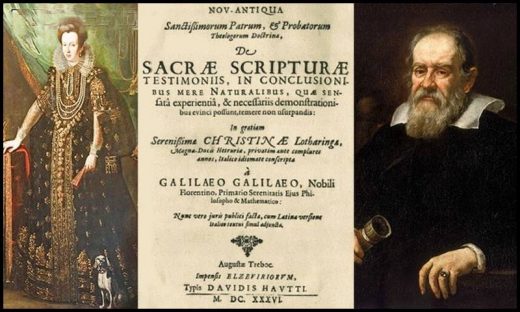“I think that in discussions of physics questions we should start not from the authority of scriptures, but from sensory experiences and necessary observations.”
In 1615, Galileo wrote a letter to Grand Duchess Christina, mother of his patron Cosimo de Medici, containing his work and defense of the Copernican System, and the letter was published in 1636. However, before this date, it was widely read and shared in intellectual circles.
So why did Galileo feel the need to write such a letter? This letter can be considered as a defense of Copernican theory. Galileo begins with a concern of the Duchess Christina. How can this be the acceptable concern of Copernican theory, which contradicts church ideas. Look at what Galileo writes about this in his letter:
“I think that in discussions of physics questions we should start not from the authority of scriptures, but from sensory experiences and necessary observations.”
Galileo thought that the knowledge of nature and the knowledge of the holy books did not conflict, and he expressed this in his letter. But what kind of contradiction is this? Are they not contradictory because they are incomparable, or is it not a question of establishing authority between the two anyway? Or are they forms of knowing that complement each other? See what Galileo has to say about this:
“We conclude that God is known first through nature, and then more specifically by doctrine…”
The motivation that prompted Galileo to produce such arguments was to put an end to the arguments that Copernicus’s Heliocentric Universe Theory, which he put forward mathematically, would be contrary to church doctrine, and to defend the idea that his own observations provided this theory. However, the thing to note here is; In this letter, Galileo not only did so, but also defended the argument that his own work and Copernicus’ theory did not contradict the Bible. By doing this, it is possible to say that he aimed not at the Bible, but at the Church that interpreted it, and that he wanted to produce a theological argument in this way, which would attract as much reaction as the defense of the Copernican theory.
Expressing that he is aware of the reaction of intellectual circles in his letter, Galileo states that his observations and findings are innovative in many respects: “A few years ago, as His Majesty well knew, I discovered many things in the heavens that had not been seen before our time. The novelty of these things, and some of the conclusions drawn from them, contrary to commonly accepted physical notions among academic philosophers, have set a few professors against me, as if I had put them in the sky with my own hands.”
However, the point that should be mentioned here is that besides his knowledge and defense that his observations confirm Copernicus’ theory, Galileo also puts forward the following argument:
“Copernicus never discussed matters of religion or belief… always based on physical results related to celestial movements and… dealing with astronomical and geometrical observations… He knew very well that if his doctrine was proven, it would not contradict the Scriptures if properly understood.”
So, Galileo takes at least two steps here: He gives advice on how the Bible should be interpreted when it comes to scientific findings, and he proposes that there is no contradiction or conflict in the right kind of interpretation.
Historians of science and religion have been arguing about this approach of Galileo, but here I will mention only one of the possibilities: By doing so, Galileo suggested the possibility of two different ways of knowing the truth, by studying nature and reading the Bible, similar questions, two different ways. This may point to something that promises to maintain a safe distance between science and religion: secularization.
Visits: 98



